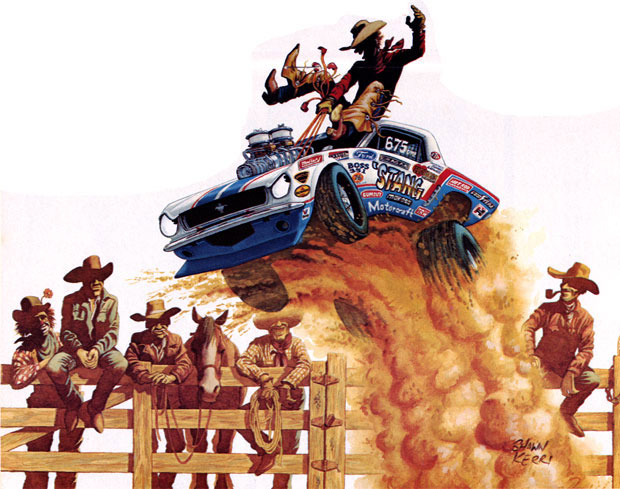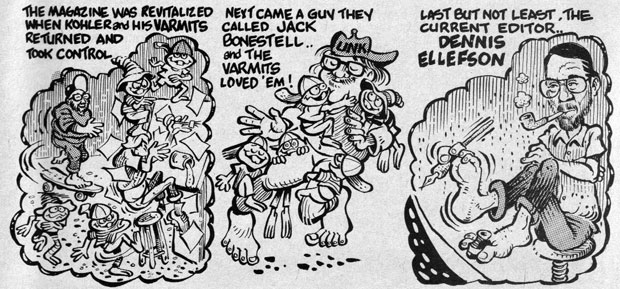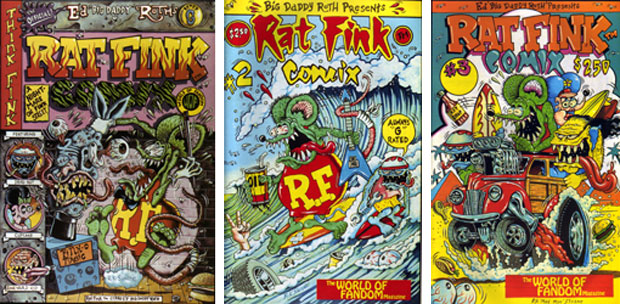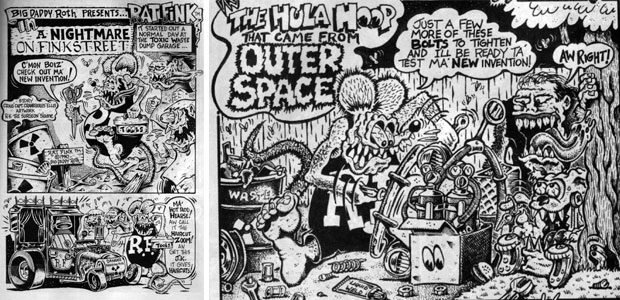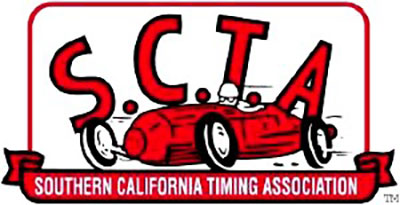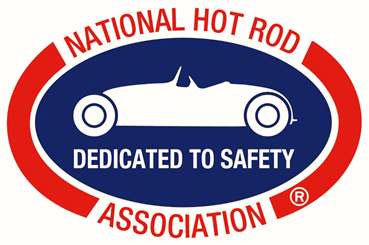
Southern California is a curse for car lovers. Rush hour traffic is
easily the worst in the nation. The gridlock that people drive through
day in and day out can take their toll on even the cheeriest person. I
get the feeling that even the Fred Rogers would have snapped at the
idiots, bottlenecks and unexplainable delays that litter even the
shortest commute. However despite all of these things So Cal is also a
blessing for car lovers. We have almost year-round perfect weather.
Perfect for driving, cruising or just staying out at night. Even on
the coldest winter days I can still hear the ice cream truck driving
through the neighborhood.
Thursdays are the best days, especially now. Winter has given up the
ghost and spring is creeping in. But that is not why people, even
those on the freeway, are moving with a certain amount of energy and
almost giddiness. I look out the window while traveling east on the
110 and see somebody else already on their way. To the rest making the
commute it's just a really nice 55 Chevy that's passing by. To those
that know what Thursday night means it's more significant. Thursday
nights are special in So Cal because they mean a break before the
weekend. A chance to take in the atmosphere of the birthplace of hot
rodding. To reconnect with our racing roots.
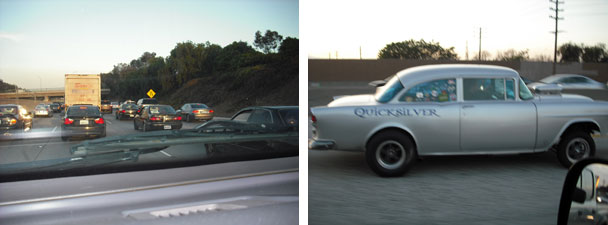
I get off a congested 110 and head north on a miserable 605
interchange. With gas prices slowly climbing I ask myself if the trip
is really worth it. The thought passes as the lanes open up. Here and
there I can spot some nice cars headed north as well. Most trained
eyes can pick them out. They seem invisible to the rest of traffic.
Just different shells all on the same road. Before too long I'm well
past the 5 and 10 freeways. I'm in Irwindale, the boonies to some,
Thursday night paradise to the rest.
You can't miss it from the freeway. Lit up like a football stadium
lies the Irwindale
Speedway. But like everybody else tonight isn't about NASCAR or
any type of track racing. Tonight all of the true car fans break out
of the routine to live. To feel alive. The Irwindale
Drag Strip hosts an open venue for hot rodders, tuners,
gearheads, mechanics and drivers with gas in their blood.

Better known to locals as Thursday
Nights Under the Lights the strip is the best place for miles to
get a taste of real Americana. Where else can you find legacy cars
lined up one right after the other? A Ford Mustang from the
double-zeros, ahead of a 5.0 from the late 80's ahead of the oldest
brother from the 60's. These were just the first I came across that
night. These were just the types of rides that make the commute every
Thursday night, weather permitting, to light the fires.
It's a bargain really. General admission is $10. Bring a few extra
bucks for tacos, hamburgers and the always awesome funnel cake. Movies
cost about that much but last far less than a night here. Movies are
also locked into one format. If you want drama you'll find it on the
track. Comedy, in the stands and action in both places. If you are
racing then it's $20, bring a license, sign a waver and the drag strip
is yours all night. Drivers can pick up their timeslip on each pass,
proof that their ride is as fast as they say, proof that their
reaction time hasn't aged a minute. The only downside is getting back
in line after each pass, but that is part of the experience. Part of a
tradition that goes back before World War II.

You'll see cars and drivers from every facet of life. Those that are
rich, poor or just getting by. Rides that are pure muscle, all
attitude or a way to escape the day-to-day. It's the communing that
people do best. It's the communing that keeps bringing them back, like
a church with a good pastor and welcoming parish. These people are
part of a community. One that embraces and appreciates what they do.
When they are lined up there is no division of what you have or where
you came from. The motto has always been the same, "run what you
brung." They are all in this for the love. The egos are left
outside, on the streets where the wannabe's think they reign supreme.
It's the people I really want to talk about. The ones who do this week
in and week out. The ones that keep the movement going. Handed down by
the gospel of racing.
Out in the parking lot you could see them getting their cars ready.
The best, or at the very least loudest, are all trailered in.
Semi-pro's, shop owners or mechanics with decades of experience that
will never be satisfied with standing still. The first I met that
night was a guy appropriately named Rod. He was looking over some
blackened spark plugs. He said that had just put them in earlier,
something wasn't right. He fussed over a beautiful blue, Mopar blue,
69 Dodge Dart. It's his pride and had just been profiled in Car Craft
magazine. April 2009 for those non-believers.

Rod was working alone in the parking lot, as were many of his
brethren. Some had friends and family accompanying them. Hanging out
at the trailer, or taking it easy in a truck or RV. Those that were
ready were in a rush to get their cars in line. Roger Conley had a
sick 67 Camaro, yellow with flames. Drivers with real beasts, cars
well over 500 horses, had welded rollcages holding everything
together. He, like many wore a firesuit and helmet to make sure he
came back in the same condition he left. Many others like Walt Brandt
and his orange Olds 442 took the line in a racing jacket. Nothing
fancy but still something to shows his colors. Like those others Walt
was eager to show what his car was capable of.

Those that worry about their gas consumption, like me, would shudder
at how much fuel these monsters could swallow in the span of a few
seconds and an eighth of a mile.
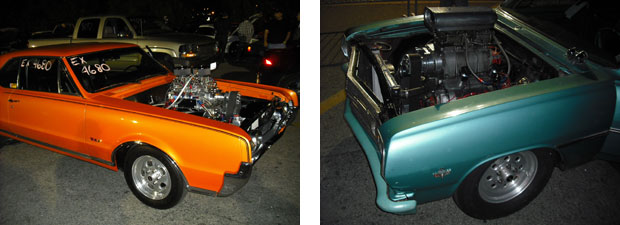
Cars and drivers from every make and model were well represented. A
yellow 1974 Karmann Ghia, still an awesome-looking ride by any
standard and her owner / driver Lance Munger. My doppleganger Omar
Felix and his 91 Civic running an Integra motor. There wasn't anything
fancy about the ride, no fat tires or sponsors but a genuine sense of
pride in his ride.

They all lined up three rows wide for their chance. As they had been
doing every Thursday night for years. The energy in the air was
palpable. The lights got brighter the closer each car got to the head
of line. It was like a Hollywood premier, showtime for the cars and
their drivers. There were no red carpets waiting their arrival, only
glassy tarmac stretching off into the horizon. The sounds were
thunderous. I don't mean thunderous as a metaphor either. The fastest
cars of the night could be heard for a long ways. The roars of their
engines deafening up close. They sent vibrations through the parking
lot. Even while idling these cars could be felt through your bones.

Racing has been a sport embraced by the masses. Ledrian was eager to
put his 68 Camaro through the paces. Friends learned the racing
harness in his seat was not for show. For Denise, a teenager, this was
a chance to show her dad that the 67 Chevy truck was rightfully hers.
The old man was right there with her, showing off the handful of
timeslips. His truck wasn't a sleeper, his experience obvious. The
engine tuned far more than stock, the tailbed open to minimize wind
resistance. All the subtle tricks of going a fraction of a second faster.
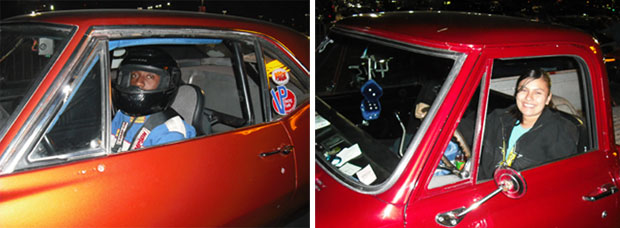
Kendell and Chéri were a lock for the Girl Power trophy and
they were also contenders for the King of the Hill tournament. Or so
many thought. Nothing was guaranteed to the duo even with the awesome
65 Nova they were running. Unlike other sports that continue to have a
division of the sexes for racing the glass ceiling was shattered ages
ago. Those holding onto the mentality that girls couldn't drive
weren't in attendance, only the racing fans were. There was a good
number of women in the crowd as were racing. The youngest girls
supporting all of the drivers and discovering role models.

Another clean ride was waiting to race right behind the ladies, a jet
black import. I asked Frank what was brought him out to Irwindale on
Thursday nights. He shook his head, wasn't it obvious? "I love racing."

Not to be outdone by the kids, the "old-timers" showed they
still had plenty of runs left in them. Freddy Steger brought a
thunderous 72 Vega Wagon, yes a wagon, to the track. He's been racing
since 18, he's over 50 now, his youthful appearance and enthusiasm
beguiles his age. Maybe racing is the fountain of youth? His car is
capable of doing the 1/8-mile track in under 6 seconds but he isn't
going to push it further. He plans on coming back again and again in
perfect running condition. Interestingly enough I caught up with the
55 Chevy that I had seen on the freeway. Dubbed Quicksilver, the
driver / owner Bud says he's only been racing a "couple of years."
Yeah, right.

Wading through the rows of cars in the staging area I came across an
amazing blue 1964 Pontiac GTO. To those unfamiliar with the legacy,
the GTO (short for gran turismo omologato) was considered the first
"muscle car" because it was the first to shoehorn an engine
meant for a full-size car into a mid-size body making it a grand
touring car. It is an even grander specimen when you hear the driver /
owner and president of the Roaders Car Club, Dennis Jewell tell the
story. He's owned the car since 78 and "married this sweetheart
after divorcing his two wives." Among the line were some very
serious racers. Running a power generator to recharge the batteries on
their cars while waiting for another run.
The strain on all the parts of the cars was unimaginable. Getting a
car to reach thousands of RPMs in under a second meant that the spark
plugs had to be firing faster than the fastest machine guns. Draining
the energy from the batteries as fast as the engine was capable of
drinking the gas. Those batteries had to be kept up or the car could
suffer a disastrous shutdown in the middle of the track, destroying a
transmission and possibly injuring the driver.

Not far from the GTO were some truly memorable rides. The early
dragster "Purple Heart" was rebuilt recently by driver /
owner Chuck Erickson. It had been out of the circuit for near a
decade. This night was a "shakedown" to make sure the rod
was in running order for the nostalgia races. Sadly he couldn't get
the wild 650 HP ride to come together that night. Better luck next
time Chuck! As for the black Volkswagen Beetle, it didn't have a
problem running that night. The little car was a real crowd pleaser,
posting some of the fastest times.
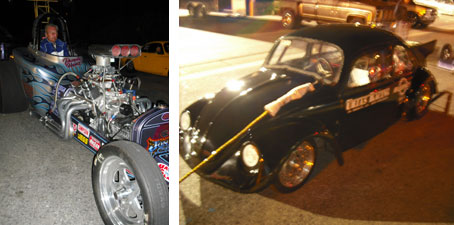
Below is a picture of a Camaro. There's no story behind it. The car
cuts such a mean profile that nothing about it needs to be said.

Of course not everybody could afford the luxury of running a beast
like the Camaro. What they brought shouldn't be scoffed at either. The
Datsun 280 Z was a bold statement from Japan. They too could build a
fast car with European styling yet at the fraction of the cost of
something like a Porsche. It could be overlooked in the sea of cars
but should never be slept on. The same thing went to the highly
tuned-Jeep Compass sitting in line. People in the stands didn't know
what to expect. It tore through everything it was placed against,
including some cars. Soccer moms been hiding a secret with this one!

The track was no place for posturing. The whole debate of rice versus
muscle that seems to be popular on message boards and YouTube videos
was completely absent here. The web and popular movies would have you
believe that it's gang warfare on the streets should the two cross.
People racing that night never had beef and were never anything but
courteous to each other like friends that hadn't seen each other in
ages. The legendary Buick Grand National, considered by some to be the
last muscle car released, ran against anything it was put against. The
original owner, a man named Paul, was there to have a good time with
his friends and family, nothing more than that.
The 93 Honda tuner that ran behind the Grand National belonged to
Chris Eimer. This import was a crowd favorite, with its cartoonish
name and fast passes. Chris said the nitrous "funny gas" was
the gimmick. The gimmick turned out to be a play on the original way
it was tuned, running nitrous and now switched to turbos and faster
elapsed times.

For some the night is filled with bad luck. Despite all that goes
into getting the cars ready, Murphy's Law dictates that the worst will
happen when you least expect it. Such was the case for Mark Mendez's
Civic. The fat tires on the front-wheel-drive have taken him into
5-second passes at the speedway. But when his turn came around
something went astray and he didn't get the car past the starting
line. Better luck next time Mark! For "Jerry" things went
much better. Chalk it up to experience but his passes were buttery
smooth all night long and his older car didn't seem to give him any worries.

Thursday nights aren't all about cars though. Much love is also given
to those running their motorcycles. Most were exceptionally tuned and
a few had wild looks to them. Gregory Williams brought his yellow
stretched ride, a 73 Honda with a turbo, nicknamed "Gigolo
Racing." These brave men and women each took passes on the strip,
undoubtedly much safer than opening up the rides on the streets or
freeways. Of course up until now I've only mentioned a few of the cars
and bikes that showed up that night. Watching the races, hanging out
with the crowd and joining in on the banter was the best part of the
show. Ask anybody that's been to a professional sporting event and
they'll tell you the same thing. Television will never, ever compare
to being there live.

The stands will fill up with friends of the drivers. Many are there
just for the show. Teenagers out late, sneaking smokes in the huddle,
making sure the ushers aren't watching. Guys and girls on dates, rowdy
boys doing a whole lot of sh-t talking, entire families stuffing
themselves with tacos and nachos and little kids waving to their
favorite cars. Clapping at passes that go down to hundredths of a
second, lamenting the rides that break down. All watching the black
Beetle disappear in the blink of an eye.
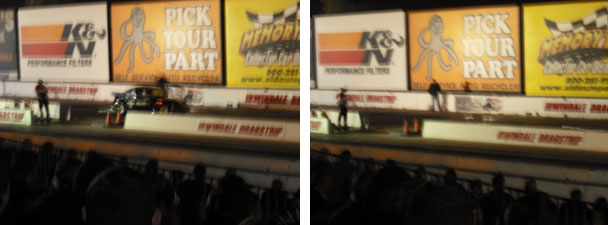
The best commentaries always come from the teenage girls in the
audience. Girls that were not in the malls flirting with the boys
still found time to make snide, but hilarious, comments about racers.
Part gossip, part social deconstruction, these girls would approve of
a solid run with a slight nod or turn their heads and brush their
bangs away from weak performances, offering critique along the lines
of "oh, I feel so sorry for you, just leave out the back where
nobody can see your car." Proof that girls with sharp claws don't
save their best lines for school.
On occasion there would be one or two rides that grab the audience's
attention. It happens every time. After a dozen muscle cars, bikes or
imports have had their fun something comes along completely
unexpected. When it happens everybody stands up, waiting to catch
something memorable in their mental DVR. Such was the case for two
wild rides. One was an ATV converted to run the track, like this one
it held its own against the other motorcycles and blew away audiences.
The other ride that the audience stood up for was a goliath of a truck
running against much smaller trucks. Some of the trucks running were
already large turbocharged diesels but none had brought a GMC
C6500 to race. Those trucks dwarf even the largest consumer
trucks. They were meant for heavy hauling duties and towing jobs. The
clean white truck was used to tow in a racer but did double duty on
the track as well. Smoking its enormous tires in the burnout and
possibly winning a trophy just for that. When it went to the line
people were stomping in the stands. The track crew barely came up to
the fenders of the beast. It blasted off the starting line billowing a
massive plume of black smoke in its wake. The track emcee made a
comment that the truck had just undone years of Al Gore's hard work in
a matter of seconds. It lost by miles, possibly the slowest ride that
night (not counting the cars that broke down) but people went crazy
for the effort. Applauding the driver as he came back in front of the
stands waving his timeslip.

Was it a symbol of the times? Reckless disregard for mother nature? A
show of force when people should be humble? A sign of excess even when
the economy is so bad? Or was it nothing more than racing for the love
of racing?
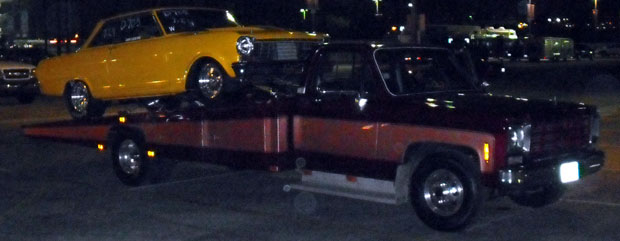
This was a celebration of what makes Southern California special and
America unique in the world. None of these drivers are millionaires,
living in the Hills and slumming it with the peasants on Thursdays.
The only claim to fame for some might be a magazine spread but nothing
that will land them a dream contract with a race team or a television
show. These are ordinary people, living ordinary lives but something
extraordinary once a week. Taking pride in themselves, taking pride in
their cars and finding glory in six seconds.

If you have a favorite fast car, or if you've ever been to a drag race I'd like to hear about it. Let me know in the comments section please. As always if you would like to sponsor me
please visit my Patreon page and consider donating each month, even as little as $1 would help make better blogs and even podcasts!


